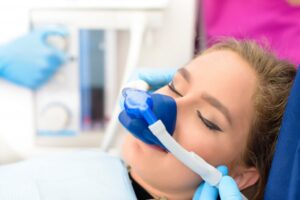
For many people, the thought of sitting in a dental chair can bring on anxiety. Whether it’s fear of pain, discomfort with sounds and smells, or a history of negative dental experiences, dental anxiety is more common than you might think. Fortunately, dentists offer sedation options to help patients feel relaxed and comfortable during treatment. Two of the most common are laughing gas and oral conscious sedation. While both reduce anxiety, they differ in how they work, their level of sedation, and what patients can expect. Here’s a breakdown to help you understand the differences.
What is Laughing Gas?
Laughing gas, also known as nitrous oxide, is a mild sedative delivered through a small mask that fits over your nose. When you breathe it in, you’ll quickly feel more at ease. Some patients describe the sensation as light, floaty, or even giggly—hence the name.
- Onset and duration: The effects kick in within minutes and wear off almost immediately once the mask is removed.
- Awake but relaxed: You remain fully conscious, aware, and able to respond to your dentist.
- No lingering drowsiness: Since the gas leaves your system quickly, most patients can drive themselves home after treatment.
Laughing gas is ideal for patients with mild anxiety, children, or those undergoing short, routine procedures.
What is Oral Conscious Sedation?
Oral conscious sedation involves taking a prescribed pill—often from the benzodiazepine family—before your appointment. This method provides a deeper level of relaxation than laughing gas.
- Stronger sedation: While you remain conscious and able to respond to instructions, you’ll feel deeply relaxed and may even drift in and out of light sleep.
- Memory effects: Many patients remember little to nothing about the procedure, which can be a huge benefit for those with severe dental anxiety.
- Longer-lasting: The sedative takes time to wear off, so you’ll need someone to drive you to and from the appointment.
Oral sedation is often recommended for more complex or lengthy procedures—or for patients who struggle with higher levels of fear.
Comparing the Two Options
- Level of sedation: Laughing gas offers light relaxation, while oral conscious sedation provides moderate sedation.
- Speed of recovery: Laughing gas wears off quickly, but oral sedation can leave you drowsy for several hours.
- Control and convenience: Laughing gas is easy to adjust during treatment, while oral sedation must be planned in advance.
- Suitability: Laughing gas is safe for most ages, including children. Oral sedation is better suited for adults with significant anxiety or complex dental needs.
Which One is Right for You?
The choice between laughing gas and oral conscious sedation depends on your comfort level, the complexity of your procedure, and your dentist’s recommendations. If you simply need a little help relaxing, laughing gas may be enough. But if dental visits trigger strong fear, or if you’re facing extensive treatment, oral conscious sedation may be the better option.
Both laughing gas and oral conscious sedation make dental care more accessible and comfortable. By reducing anxiety and helping you relax, they ensure that fear doesn’t stand in the way of a healthy smile. Talk to your dentist about your concerns and medical history so together you can decide which sedation method will help you feel most at ease.
About the Practice
Whether you find it difficult to sit still for a long time or have had a bad dental experience in the past, here at Smile Keepers, we have a solution to ensure you have a comfortable, relaxed visit. With sedation dentistry, we can administer nitrous oxide, oral conscious, or IV sedation – all methods to calm your anxious mind. Sedation methods are available for patients of all ages, and if it’s a dental emergency you find yourself in, we’ll get you in quickly with a same-day appointment. Schedule your visit online or call our Brenham office at (979) 830-5022.
